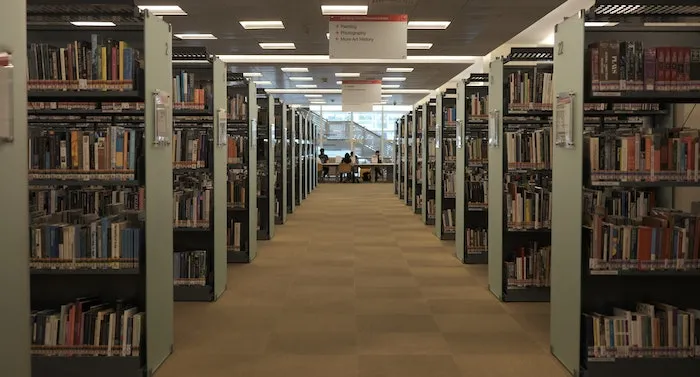
10 Tidbits About Libraries for Visually Impaired and Print Disabled People

Reading encompasses a variety of ways of engaging with narratives and ideas. And around the world, a number of specialist libraries focus on readers with particular physical or cognitive needs. These libraries offer an impressive range of features. Here are just ten things you might not know about libraries designed with visual impairments and print disabilities in mind.
1) More people are eligible than you might think. These specialist libraries may have the word “blind” in their names, but they often provide services to a bevy of people: those with conditions that lead to limited vision, such as macular degeneration; those with conditions associated with print disabilities, such as dyslexia; and those with other conditions that make it hard to read a conventional printed book, such as arthritis or lupus. Seniors and children alike may qualify and benefit, for instance, from large-print books.
2) These libraries might offer books unavailable anywhere else. Elizabeth Burns is head of reader services at the Talking Book & Braille Center (TBBC) in New Jersey, USA, which has over 13,000 registered patrons. Burns notes that their service range “covers more people than you think. And we have books that you can’t get, in all honesty, for love or money, unless you’re a member of our library.” This is partly because many of these specialist libraries are explicitly not competing with commercial publishers (or mainstream public libraries), and don’t have to follow commercial dictates. Some have special copyright arrangements allowing them to produce or distribute accessible versions of books, only to people with print disabilities or visual impairments. The Lithuanian Library for the Blind (LLB), headquartered in Vilnius, is the largest publisher of special-format books in Lithuania, producing 400 books a year.
3) Collections may include books with images. The TBBC’s Burns explains, “We have picture books in what’s called print Braille, where it’s the picture book and it’s the Braille; both are in the same book. And that helps if you have a sighted parent reading Braille to a child; they can read the picture book while the child follows along in the Braille. Or also what happens frequently is the other part, where it’s the Braille-reading grandparent who wants to read books to their sighted grandchild.” There may also be some tactile versions of books. Graphic novels and comics aren’t yet well represented, Burns acknowledges.
4) Some libraries have collections of accessible sheet music. In Zurich, Switzerland, the Schweizerische Bibliothek für Blinde, Seh- und Lesebehinderte creates its own Braille sheet music, as well as supplying sheet music produced by others. In Ho Chi Minh City, Vietnam, the Sao Mai Vocational and Assistive Technology Center for the Blind curates an accessible music library, using its own software to translate sheet music into Braille.
5) Some more niche and nostalgic categories may be well represented. As seniors make up such an important demographic for library services that accommodate visual impairments, there’s high demand for genres popular in seniors’ youth. In the UK, for instance, the National Accessible Library has a “sea and air” category of books.
At the TBBC in New Jersey, it’s all about the westerns. Burns chuckles, “Our Western lovers, they call and they’re like, ‘Why do you mean there isn’t anything new? This is the most important area of books there are and there can’t be enough.’” The TBBC patrons also include many veterans, so the library stocks plenty of nonfiction books pertaining to World War II, the Vietnam War, and the Korean War.
6) These libraries may host special programs, like robotics training for teenagers and tactile story listening for children. The LLB in Lithuania has been at the forefront of such special programming.
Dalia Balčytytė, head of the LLB’s information resources department, explains that a story box is a collection of objects that correspond to the items mentioned in a story. “The purpose of a story box is to create hands-on literacy experiences for blind and visually impaired children. But our work experience has shown it to be a wonderful tool for children with autism spectrum disorders and all children with learning difficulties or other disabilities.”
For instance, one of the story box stories, by Kęstutis Kasparavičius, involves a tea party. As the story is performed, children decorate their own tea cups. In another activity they interact with scented objects associated with summer, and create flower-related crafts.
7) Users may be able to borrow or learn about accessible devices. In New Jersey, the Library Equal Access Program (LEAP) offers free training to older adults on the text magnification and text-to-speech functions of smartphones and PCs. Across the US, the National Library Service provides digital talking-book players for free.
8) The materials aren’t limited to books. Users may be able to get help with registering for a news reading service, for instance.
9) These libraries may depend on volunteers – for example, for sourcing, transcribing, and recording audiobooks, sometimes in custom recording studios. The nonprofit group Volunteers of Vacaville runs The Blind Project, in which incarcerated people learn and provide Braille services. Serial killer Edmund Kemper was among those who recorded a number of audiobooks as part of the project. While The Blind Project primarily supplies schools rather than libraries, it shows how important volunteers can be to underfunded literacy programs for visually impaired people (although of course the primary responsibility for providing resources should lie with the government).
10) The COVID-19 pandemic has further demonstrated the utility of digital formats. Burns, of New Jersey’s TBBC, reports that more users have been willing to try downloading audiobooks during the pandemic, and many seniors have been enlisting the help of younger family members in experimenting with digital formats. In-person outreach has been challenging, but the TBBC librarians have long been used to providing services via phone, email, and mail.
The LLB’s Balčytytė says that the pandemic has also accelerated some of its digital services, such as online trainings. And the number of active users of their virtual library has skyrocketed. “Yet, it is more complicated with events for users – as quite a number of our elderly users do not use technologies it did not work to move the weekly book-club meetings to Zoom. Waiting for the better times!” One quarantine-era response has been to turn some live events into in-home experiences; the LLB has been mailing some story boxes to families, accompanied by a memo prepared by library specialists.












